Commissioner for Fair Access annual report 2019: building on progress towards fair access
Second annual report from Commissioner for Fair Access, in which he assesses the progress on fair access in Scotland.
Chapter 1: Review of Progress
The national picture
Gaps in application, acceptance and entry rates between young people from SIMD20 areas and those from less deprived communities have narrowed since 2013 and, in particular, during the past two years since the publication of the Commission on Widening Access final report. But large gaps remain. Progress has been made towards making access to higher education fairer. But much work remains to be done. Young people from the most deprived communities continue to lose out on getting into university - and, to a lesser extent, in retention, among those who do enter. Even when they get good degrees, they are still discriminated against in the labour market - in particular, in the elite professions.
Application rates from 18 year-olds in SIMD20 areas reached a peak of 17.2 per cent in the 2017 cycle but fell back slightly to 16.9 per cent last year (Chart 1). The difference in application rates among 18 year-olds from the most and least deprived communities has decreased by 2.3 percentage points since 2016. But the gap remains wide. Young people from the least deprived communities are still almost three times more likely to apply to university than their peers from the most deprived areas (49.9 per cent compared to 16.9 per cent).
Chart 1: 18 year-old application rates by deprivation quintile (SIMDQ1 = SIMD20), 2013 to 2018
Source: UCAS
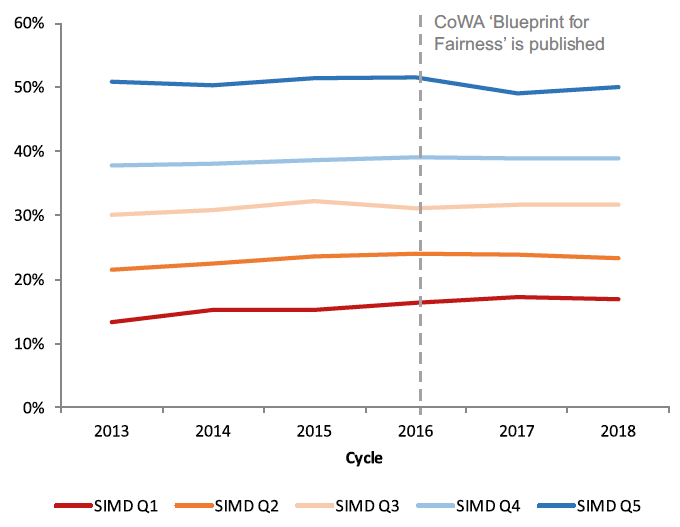
Over the past two years, offer rates among 18 year-olds also increased faster for SIMD20 applications (12 percentage points) and SIMD20-40 applications (7.1 percentage points) while for applications from the three other SIMD quintiles there was only a modest increase (Chart 2). Compared to average offer rates, which take into account such factors as the course requirements and grades, offer rates for SIMD20 applications were higher than expected (6.8 percentage points higher). The same was true of SIMD20-40 applications (5.0 percentage points higher). However, offer rates for applications from the next two SIMD quintiles were slightly lower than expected, while for those from the top quintile offers were in line with expectations, although acceptance rates continued to increase for these quintiles. This pattern may lend limited support to the thesis of the 'squeezed middle', that applications from the mid social ranges have been affected most in terms of offers from the drive to achieve fair access.
Chart 2: 18 year-old offer rates by deprivation quintile (SIMDQ1 = SIMD20), 2013 to 2018
Source: UCAS
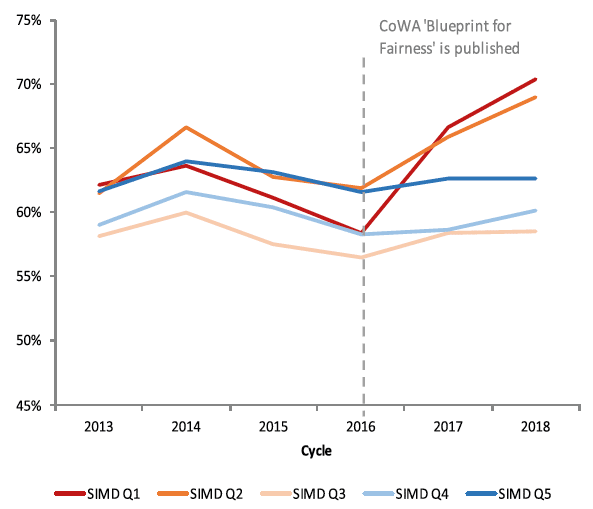
Acceptance rates have increased for 18 year-olds from all SIMD quintiles to over 70 per cent. The largest increase was for SIMD20 applicants (by 11.5 percentage points between 2016 and 2018) (Chart 3). But the highest percentage of accepted applicants was still among those from the top SIMD quintile, at 75 per cent. A similar pattern can be observed in entry rates (Chart 4). Although the most rapid increase was for SIMD20 (2.2 percentage points higher in 2018 than two years earlier), entry rates (the proportion of 18 year-olds entering university) for those from the least deprived communities were still more than three times higher than for those from the most deprived communities. Moreover, there is still a gap between retention rates between SIMD20 students and the overall sector. But the differences are small - 89.4 per cent compared with 92.5 per cent respectively according to the latest figures. It is worth emphasising that even the lower rate is exceptionally high by international standards.
Chart 3: 18 year-old acceptance rates by deprivation quintile (SIMDQ1 = SIMD20), 2013 to 2018
Source: UCAS
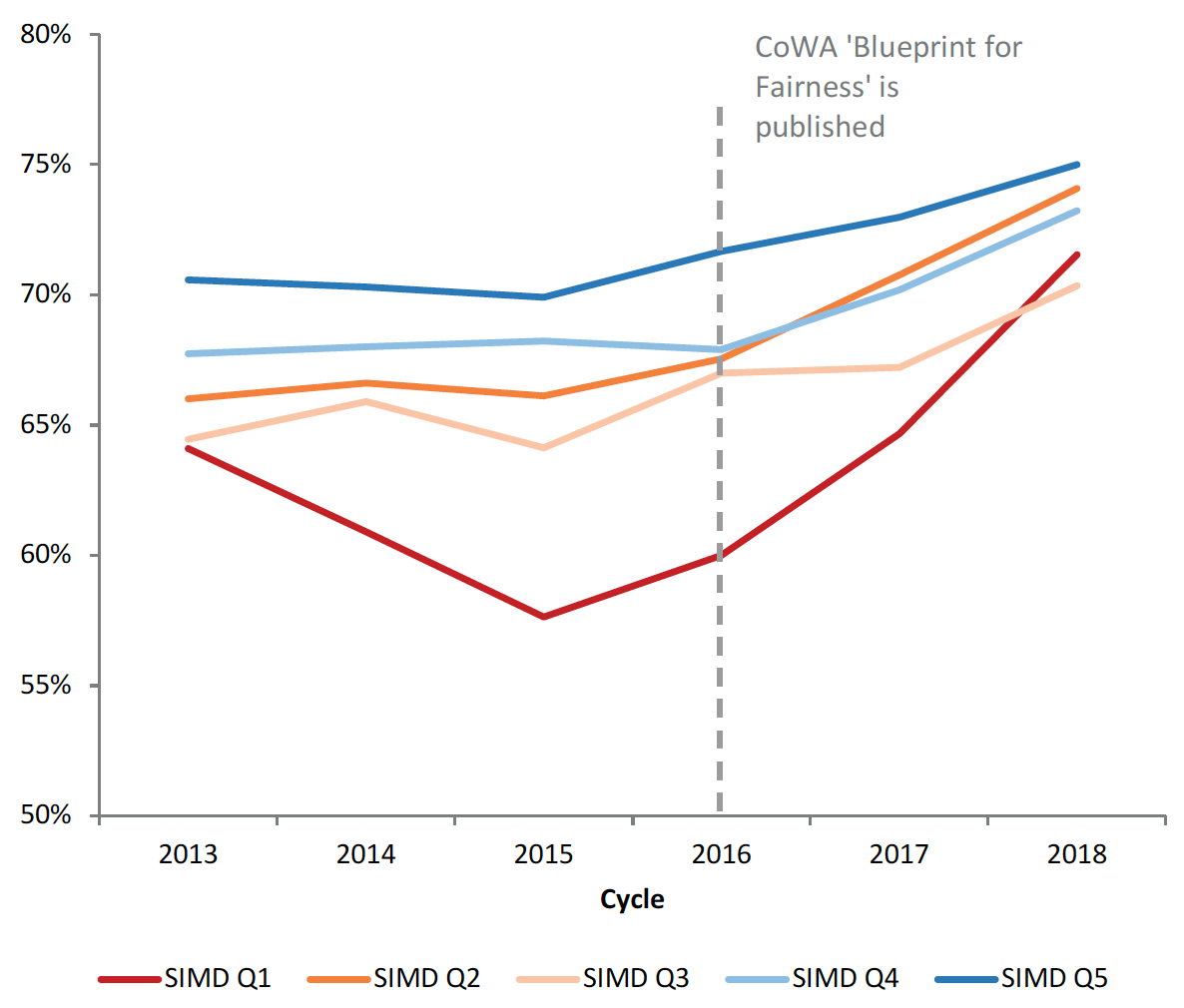
In an earlier discussion paper, three broad clusters of institutions were identified in the context of admissions: Group A (institutions with a comparatively high percentage of SIMD20 applicants and offer rates broadly in line with expectations); Group B (institutions with a lower percentage of SIMD20 applicants and also offer rates broadly in line with expectations); and Group C (institutions with a lower percentage of SIMD20 applicants but offer rates higher than expected). Group A consists entirely of 'post-1992' universities, and Groups B and C a mix of 'post-1992', ancient and other more recently established universities. Between 2016 and 2018 an interesting shift has taken place. The number of universities in Group C has expanded from three to seven, and now contains three ancient universities (up two), three more recently established universities (also up one) and one 'post-1992' university (there had been none in this group two years earlier). The two other groups are now dominated by 'post-1992' universities. This shifting pattern raises interesting questions, although a number of interpretations are possible.
The proportion of SIMD20 entrants still varies considerably between universities. As of 2017/18, the University of the West of Scotland has the highest - 29.4 per cent. The University of Aberdeen has the lowest - 6.0 per cent (although the fact that Robert Gordon University, the 'post-1992' university in the same city, also has a low rate - 6.5 per cent - suggests that SIMD is a much less useful metric in the north east - as it is in all regions with more scattered populations). Stirling and Dundee have been especially successful in admitting SIMD20 students, doing better than some 'post-1992' universities. The University of Glasgow is the most successful 'ancient' university in terms of SIMD20 recruitment. It has already comfortably exceeded its 2021 target. The University of St Andrews has increased its percentage of SIMD20 entrants by almost 50 per cent since 2016, although from a low base. The percentage at the University of Edinburgh has also increased at a similar rate, from a higher base.
Chart 4: 18 year-old entry rates by deprivation quintile (SIMDQ1 = SIMD20), 2013 to 2018
Source: UCAS
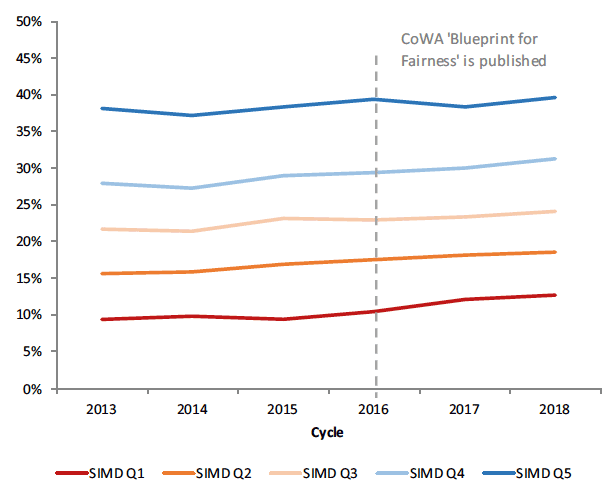
These national level statistics suggest that real progress has been made towards meeting fair access targets, although students from deprived backgrounds are still concentrated in particular types of institutions. More detailed conclusions and recommendations appear at the end of this section, and data tables are provided in an Annex.
Policy developments
Outreach and bridging programmes
Over the last year, the Scottish Funding Council has taken the lead in this area of implementation, establishing both an Access Programmes Steering Group (APSG) and a Bridging Programmes Advisory Group (BPAG). The APSG, on which a wide range of stakeholders is represented, has a wider remit covering all access programmes. Its primary task is to examine the extent to which a coordinated Scotland-wide framework for access programmes can be developed to reduce fragmentation and duplication. Such a framework would make successful completion of an access programme more portable, although it is recognised that many programmes have been developed in specifically local contexts and are based on close collaboration between schools and colleges and universities. The APSG will also examine the feasibility of SCQF credit rating of access programmes. The group met for the first time earlier this year, so its work is at a preliminary and exploratory stage.
The BPAG, chaired by Professor Frank Coton of the University of Glasgow, also met for the first time in March 2019. Once again it will examine how academic credit earned by successful completion of bridging programmes can be made more portable and also how it can be suitably recognised in contextual admissions. The group is focusing on summer schools and top-up programmes delivered in the later years of secondary education. As with the APSG, its work is at a preliminary and exploratory stage, consisting initially of a mapping exercise of existing provision.
Although accurate, comprehensive and up-to-date information about existing bridging and, more broadly, access programmes needs to be collected and made available, it is important that exploration is rapidly transferred into action. Many of the issues were explored in considerable detail by the Commission on Widening Access, which reported three years ago. They were also highlighted in my first Annual Report as Commissioner for Fair Access.
The Framework for Fair Access
The development of a Framework for Fair Access was a key recommendation of the Commission on Widening Access. Over the past two years this work has been undertaken by the Framework Development Group chaired by Conor Ryan, then Director of Research at the Sutton Trust, and composed of stakeholders and experts. The group decided that the Framework should have two elements:
1. A toolkit to serve as an online repository of best practice on evaluation of access initiatives and of summaries and evaluations of the available evidence on which initiatives have been most effective. Funding was secured from the SFC to commission CfE Research to develop the toolkit;
2. A community of practice to bring together access practitioners and researchers. Once again the SFC has provided funding to recruit a development coordinator to support this development. Scotland's Community of Access and Participation Practitioners (SCAPP) has now been established.
The Framework for Fair Access was formally launched in May 2019. The Framework Development Group has now been replaced by a Framework Governance Group chaired by myself as Commissioner. The establishment of the Framework means that Scotland is a 'path finder' in making consistent and reliable information on the evaluation of access initiatives available in an accessible form. The Office for Students (OfS) in England is only now developing a systematic approach to producing a database on good practice.
Despite this, two conditions need to be met if the Framework is to be a success:
- First, the Framework must be 'owned' by access practitioners and other stakeholders. My role, and that of the SFC and other organisations and of institutions, is to facilitate not to direct. Although it is important that the development of the Framework is linked to, and coordinated with, other initiatives. Equivalent work in England is clearly the responsibility of the OfS, which makes it part of the overall regulatory framework;
- Secondly, the Framework will require secure and dedicated funding to make it sustainable into the future. Resources will be needed to expand, and update, the toolkit, especially if it is also to include evidence on evaluations of good practice in access in other countries. SCAPP will also need adequate and reliable support. Currently no firm decisions have been taken about the longer-term funding of the toolkit and community of practice. This will be considered by the Framework Governance Group later this year.
Minimum entry requirements and contextual admissions
Good progress has been made on establishing, what universities are calling, Minimum Entry Requirements (MERs), although the position with regard to contextual admissions more broadly is less clear. All universities have agreed MERs for 2020/21 entry. Typically, the difference between MERs and standard entry requirements is two Higher grades, although it can be as much as four Higher grades (and one fewer Higher). Some universities have also indicated they may still accept applicants with less than the published MERs.
However, it is difficult to form an overall assessment of their likely impact. Although universities publish standard tariffs for entry, many already admit applicants who do not meet these published tariffs. 'Headline' tariffs are sometimes established with an eye to enhancing the 'market' position of universities, in league tables and other contexts. Standard entry requirements, against which MERs are measured, also fluctuate - between universities and degree courses as well as year by year depending on the shifting balance between supply and demand. The result is a lack of transparency about the allowance that is made for applicants from disadvantaged backgrounds. Making this process more transparent is a complex task. However, it is essential that applicants, and those who advise them, have the best possible understanding of the allowance that has been made because this represents the degree to which they are being encouraged to apply, which in turn may influence their choices about which institutions and courses they should apply to.
Not only are standard entry requirements both variable and to some extent fluid, there is also a lack of consistency - and so transparency - about the contextual factors that universities take into account in making MERs. The problem is twofold:
- First, a broad view is taken of these contextual factors. For example, according to a survey by the Universities Scotland Admissions Working Group, 47 per cent of entrants to St Andrews and 52 per cent of accepted offers at Edinburgh have at least one contextual 'marker'. Clearly only a minority of these 'marked' applicants and entrants are socially deprived, even on the most flexible definition. There is also substantial variation in the proportion of Scottish domiciled applicants with contextual 'markers' between universities - 28 per cent at Strathclyde compared with 42 per cent at St Andrews. Although a standardised list of contextual factors may be undesirable because each university rightly wants to select the factors that are most appropriate (and the weighting they should receive) for their own particular student constituencies, there is a strong case for convergence towards a more limited number of contextual factors;
- Secondly, contextual factors are used in different ways. In some universities (and courses) they merely lead to special consideration, perhaps unspecified; in others to more specific advantages, such as a guaranteed interview; in others again to guaranteed places if applicants meet MERs (which may themselves be varied if applicants have taken an access or other preparatory course). To some extent this is inevitable. The process of selection is necessarily different between different courses and subjects - for example, for fine art or for business studies courses. However, once again there needs to be greater effort to make the admissions process for applicants with contextual 'flags' (relating to social disadvantage) more transparent, which will require greater consistency and commonality.
The major issue with regard to the use of MERs and contextual admissions, still unresolved, is the extent to which that use should be limited to 'flexing' entry standards within strict limits set by traditional ideas about which students have the academic ability to benefit (given the right level of support), or whether MERs and contextual admissions should be used in more radical ways - both to challenge some of these traditional ideas and also to meet the larger requirements of social justice. This dilemma goes to the heart of the debate about fair access to higher education.
It would be naive to imagine this is an easy issue to resolve. There is, rightly, concern that students lacking the necessary degree of preparation for rigorous study at degree level should not be set up to fail, although there is research evidence that suggests much bolder use could be made of contextual admissions before continuation rates and degree outcomes are seriously put at risk. In setting MERs, universities have lent on the expert advice of subject specialists and admissions staff in academic departments who are best placed to decide how far standard entry requirements can be reduced by without compromising students' chances of success. The support of the grass-roots academic community is crucial.
However, there is a risk, especially in the more selective universities and for the most competitive courses, that these expert judgments will tend to be too cautious and conservative, overdetermined by their experience of the 'performance' of students from privileged social groups (more in terms of behaviour and attitudes perhaps than of academic standards narrowly defined). It is encouraging, therefore, that Universities Scotland has agreed that MERs should be reviewed - and possibly reduced. There are powerful arguments that, to some degree, expected standards of academic achievement and behaviour reflect assumptions shaped by the experience of existing university students - many of whom are drawn from the more socially advantaged groups. Although analogies should be used with care, a similar argument has been used about the 'gendering' of some academic disciplines, disadvantaging female students.
Articulation
The National Articulation Forum (NAF), co-chaired by Professor Nigel Seaton, Principal of Abertay University, and Liz McIntyre, Principal of North East Scotland College, met for the first time in April 2018 (although its plan was only signed off earlier this year). It had its most recent meeting on June 4. Its aims are to explore: the extent to which articulation is understood as a pathway to university by potential applicants; the outcomes achieved by articulating students; current models of articulation; regional as opposed to local patterns of articulation; and - crucially - the subjects where there is most articulation (and the least). As with the APSG and BPAG, the work of the NAF is still at an early stage and has largely been exploratory. As with these other groups, it is important that the NAF moves swiftly beyond this exploratory phase.
The urgency of its work has been highlighted by the disappointing progress made towards improving articulation rates between Higher Nationals (HNs), both Higher National Diplomas (HNDs) and Higher National Certificates (HNCs), and degrees, as highlighted by new experimental statistics from the SFC's revised National Articulation Database. Instead of the step change that is needed, only gradual improvement has been made. This is a major issue. Currently more than one in four first degree entrants (26.1 per cent) comes via an HN route, although around 60 per cent (and 80 per cent of those with advanced standing) are to be found in only four universities - West of Scotland, Glasgow Caledonian, Robert Gordon and Napier. Although not all articulating students with HNs come from deprived communities.
Between 2014/15 and 2017/18, the proportion of HND students progressing to degree courses who received advanced standing, i.e. full credit, and therefore, direct entry into Year 3, only increased from 59.1 to 64.3 per cent (Chart 5), still well short of the 75 per cent target suggested by the Scottish Funding Council, which I endorsed as a minimum goal in my first Annual Report. The proportion of HNC students progressing to degrees who received advanced standing, i.e. entry into Year 2, was even lower. Over the same three years it increased from 28.7 to 34.1 per cent. Almost two-thirds still receive no credit. The figures for individual universities are even more disappointing. At Glasgow, only 13 HN students received full credit, compared with 224 who received no credit. Even at Glasgow Caledonian, where 990 HN students received full credit, a substantial number - 707 - received no credit.
The various explanations of, and justifications for, this reluctance to allow HN students advanced standing on degrees were discussed in my first Annual Report. They include students switching subjects and/or not wishing to receive full credit to allow themselves more time to acclimatise to degree-level study, a poor 'fit' between the HN and degree curriculum even in the same or similar subjects, and the belief that there are important differences between HNs and degrees in learning style and culture (or even that there is some kind of existential gulf between higher professional and vocational education and a university education). Some of these explanations are valid; others are not.
Chart 5: Percentage of Scottish domiciled students articulating within three years of HNC/HND completion that gained advanced standing, 2014-15 to 2017-18
Source: Scottish Funding Council
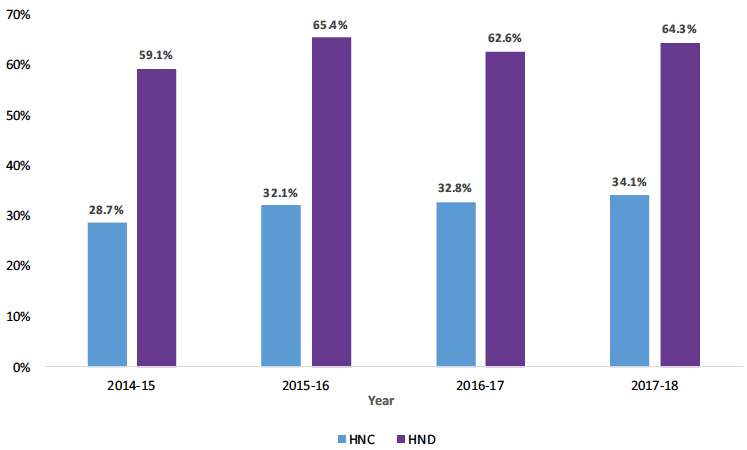
This failure to make faster progress towards fuller and smoother articulation between HNs and degrees has damaging results:
- First, it reduces efficiency by increasing the length, and therefore the cost (for both students and taxpayers), of the higher education of articulating students;
- Second, it makes it more difficult to achieve a properly integrated tertiary education system across Scotland with seamless progression;
- Third, it makes it harder to promote other forms of articulation - for example, efforts to rationalise S6 (in particular, Advanced Highers) and the first year of degrees or between emerging patterns of virtual and work-based programmes and more traditional provision;
- Finally, and most damagingly, it works against fair access. Although not all HN students come from socially deprived backgrounds, they are more likely to do so. While around 26 per cent of all Scottish domiciled first degree entrants have an HN, the proportion of full-time first degree entrants from SIMD20 areas (the 20% most deprived areas) that have an HN is 42 per cent.
Discussion, conclusion and recommendations
Student number statistics suggest that real progress has been made towards meeting the interim 2021 target of 16 per cent of (full-time first degree) entrants to Scottish universities coming from SIMD20 areas, which has almost been met. This gives a high degree of confidence that the 18 per cent target for 2026 can also be met, and reasonable confidence that a truly level playing-field can be realised by 2030, or even earlier. However, it continues to be challenging for some universities to meet the 10 per cent institution-level target by 2021.
There continues to be an uneven pattern of opportunities for applicants from more socially deprived backgrounds, who are still concentrated in colleges and in most 'post-1992' universities. Some more traditional universities have excellent records on recruiting SIMD20 entrants; others have much further to go. It is perhaps time to focus more on achieving a fairer distribution of opportunities for SIMD20, and other disadvantaged, applicants rather than on the headline figure for the higher education sector as a whole. Although it would be unrealistic to expect the same student mix across all institutions.
More concerted efforts to promote fairer access, such as establishing minimum entry requirements and developing a more consistent approach to contextual admissions, improving articulation rates between HNs and degrees, and creating stronger regional (and national) frameworks for access courses and bridging programmes, have begun well. But some are still at an early stage, and clear measures of success have not always been developed. It is important to move on to the next stage, to embed these initiatives and to be able to measure progress against targets.
Recommendations to drive progress
The development of more stretching targets for fair access, at both national and institutional levels, should be considered - perhaps by bringing forward the 2026 and 2030 targets and by setting targets for a more even distribution of SIMD20 and other disadvantaged students across higher education.
Although the establishment of MERs is a welcome achievement, they should be reviewed in the light of experience gained in their use. In particular, MERs should be calibrated to achieve institutional targets for admitting students from socially deprived backgrounds, and students admitted with MERs should have access to continuing academic support.
More challenging targets for the proportion of articulating students with HNs should be set. The default position should be that they receive advanced standing. Universities which offer less should be required to justify their decisions on a case-by-case basis. A target of giving advanced standing to at least 75 per cent of applicants with HNDs, and 60 per cent of those with HNCs, by 2021 seems reasonable. Steps would need to be taken to ensure more traditional universities did not respond by reducing the number of offers they make to HN students.
A national framework for access and bridging programmes should be established based on curriculum with a common core and leading to portable qualifications. The work of the Framework for Fair Access and of the two SFC-led groups on access and bridging programmes should be directed towards that goal and their activity aligned.
The Framework for Fair Access should receive adequate, dedicated and sustainable funding. It should not be treated as another short-term initiative. Instead it should be established as a permanent instrument for promoting good practice in fair access (although its effectiveness should be reviewed within three years).
Contact
There is a problem
Thanks for your feedback